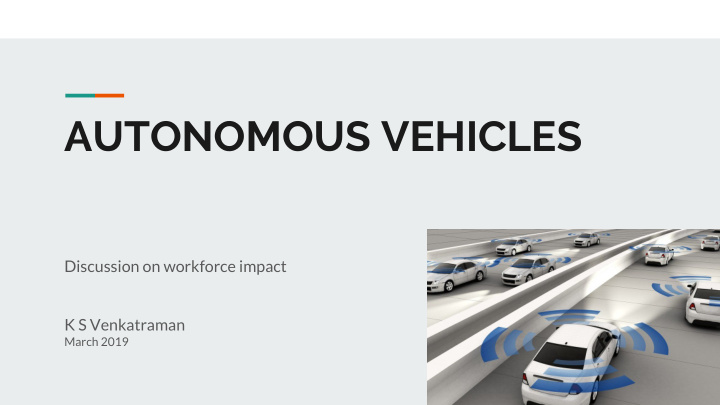



AUTONOMOUS VEHICLES Discussion on workforce impact K S Venkatraman March 2019
DISCUSSION OUTLINE Historical perspective and the AI revolution Technology potential Workforce Impact, Risks and Opportunities Preparing for the transition Q&A
HISTORICAL PERSPECTIVE Technological revolutions ● Printing press, Automobiles, Computers, Internet, Smartphones, Farm and factory automation ○ Led to workforce changes ○ Examples of job displacements ● Agriculture ○ 1870: 50% of the US workforce employed in agriculture. Now: less than 2% ■ 1955: 500,000 elevator operators in the US ○ Bank tellers grew from 485,000 in 1985 to 527,000 in 2002, offering various financial services ○ Technology will continue to advance ● Creates new opportunities for us to understand and embrace ○
AV TECHNOLOGY AND ITS POTENTIAL Rapid advancement in Artificial Intelligence makes AVs possible ● Most significant transportation industry innovation ● Since the invention and introduction of the automobile ○ Potential to influence: ● Safer transportation for passengers, pedestrians and bicyclists ○ Needs security, extensive testing and regulatory oversight ■ Climate change by reducing car ownership and pollution ○ Increasing rideshares, mass-transit, Autonomous EVs ■ Access to transportation, particularly the disadvantaged ○ Providing access regardless of age and ability ■ Reduced congestion and increased productivity ○ Replacing parking spaces with ‘useful’ real-estate ■ Reduce time spent in congestion with productive work ■
WORKFORCE IMPACT DUE TO AUTOMATION
PERCEIVED WORKFORCE IMPACT 3.8 million americans operate motor vehicles (trucks, delivery vans, buses and taxis) ● Most common occupation in 29 states. ○ ~1 million people drive for ridesharing services ○ Potential to affect related industries ● Insurance, Truck stops, Motels, Body shops, garages etc. ○ US dealerships employed 1.3 million people in 2016 ○
WORKFORCE IMPACT: OPPORTUNITIES Large scale development and deployment of autonomous vehicles ● 250% increase in job listings year over year (2017-18) ○ AV service technicians ■ Safety, security, mechanical, electrical and computer engineers ■ Construction: smart highways and AV infrastructure ○ Dealerships for AV sensors and parts ○ Shift in driver responsibilities ● Order processing ○ Inventory management ○ Sales and customer service ○ Future Opportunities ● Remote vehicle operators, monitoring for AV fleets ○ New “passenger economy” ○ Goods and service provided to passengers during their ride ■ Health and personal care ● Meetings and entertainment services ●
PREPARING FOR THE TRANSITION Identify labor force training needs ● Transportation and related industry sectors ○ Worker-centric policy ● Influence public and private training programs, apprenticeships ○ Identify modifications to existing programs ○ Focus on sector specific, career-connected training ○
Recommend
More recommend